Did you know that an empire fell because of a question of prayer? Many books have been written about hesychasm, or stillness, as it is formally called. I’ve been researching these books for a few years and would like to say something briefly on the subject.
Prayer by Reading
Long ago, during the Serbian Empire under Tsar Dušan, a great theologian and bishop, Saint Gregory Palamas, lived on Mount Athos. At that time, he had a lively debate with another bishop, known as Barlaam of Calabria, about the proper way to pray. Palamas advocated for the silent prayer of the mind, where a person addressed God within their thoughts, while Barlaam argued that prayer should be performed aloud and according to a set text.
Barlaam initially was an Orthodox priest, but under the influence of Catholic teachings, he sided with the Pope and became a Catholic bishop in Calabria. Catholics disliked the idea that a person could converse with God inwardly, on their own will. They believed that not everyone should be free to speak to God as they wished, and that prayer should be performed aloud and follow a prescribed text.
At that time, the Catholic Church, having conquered Constantinople in 1204, was gradually taking over Orthodox territories. Fearing rebellion and conspiracy from former Orthodox believers in those regions, Catholics insisted that prayers be recited aloud, not in silence, as silent prayers might allow believers to secretly hold on to Orthodox values. They particularly emphasized aloud recitation of the “filioque” to ensure believers would slowly convert to their heresy.
Barlaam of Calabria wrote letters to Palamas, and Palamas responded, refuting his claims. Catholics mocked the Orthodox practice of silent prayer, calling its practitioners “navel-gazers” because of the attention they paid to breathing and the movement of the stomach (navel – omphalopsychia). They ridiculed them, saying they erred and fantasized with closed eyes.
Of course, much of what I’m writing here cannot be found explained this way in books, as most were written in the 20th century when it was not safe to speak openly against the Latins and Jews. The explanations are usually overly long and convoluted, making it hard to grasp the essence of the issue without patience.
The point of changing prayer to a reading-based form was to control the thoughts of the faithful and, in doing so, break any resistance. The Orthodox Church stood in defense of the old way of praying. This struggle between the Latins and Orthodoxy occurred right in Constantinople and became a battle for the imperial throne, with the Kantakouzenos family supporting Orthodox prayer, and the Palaiologos family siding with the Catholics. This throne struggle and defense against Catholic influence escalated into a full-blown civil war.
The debate wasn’t just about prayer; it expanded to more dimensions: the conflict between the Platonic and Aristotelian philosophical schools, between idealism and realism, between Latin and Roman cultures, between monks and the clergy, and finally, between political factions, leading to a true civil war.
This issue was so important that several church councils were convened, several patriarchs were replaced, and at one of these councils in 1345, Gregory Palamas, who was then the bishop of Thessaloniki, was even excommunicated, i.e., expelled from the church, when the Latin side gained control at the court.
In 1346, on Mount Athos, Tsar Dušan met with Father Palamas and offered him to come to Serbia, where he would receive all the necessary support and resources. However, Palamas politely declined, saying he already had everything he needed, as his world was spiritual, not material.
In the power struggle between the Palaiologos family, who allied with the Latins, and the Kantakouzenos family, the influence of Tsar Dušan was crucial. Alliances shifted, but in the end, a church council was held in 1368, where the practice of silent prayer was declared an integral part of the Christian faith, and Gregory Palamas was proclaimed a saint. Gregory Palamas had died eight years earlier.
I’d like to emphasize that the civil war, Latin Church influence, and the attempt to unite with the Vatican led to the Serbian Church being elevated to the level of a patriarchate in 1346, and proclaiming Dušan as Emperor, preventing the Greeks from making a deal with the Latins.
The Palaiologos family’s decision to ally with the Latins was a mistake, leading to their downfall. The Greek Church’s fall into heresy is what weakened the empire, giving the Turks a chance to defeat the Byzantine Empire.
Unfortunately, for the past century, our historians have claimed that Tsar Dušan founded the patriarchate to grab power during the civil war, never mentioning the real reason behind it.
Jesuit Influence
However, even though Gregory Palamas defended the Jesus Prayer, the struggle wasn’t over. What the Latins couldn’t achieve in the 14th century, the Jesuits succeeded in the 18th century through books and Catholic enlightenment.
I’ve written about the silent, or prayer of the mind, which a monk from Hilandar taught me. Today, many don’t practice silent prayer but instead read “evening” and “morning” prayers, which someone else wrote, making it easier for people to pray without thinking too much. I must say that this type of prayer is precisely what the Catholic Church tried to introduce into our Orthodoxy.
During the Austro-Hungarian Empire, the Catholic Church and Jesuits did everything to convert the Orthodox to Catholicism, or at least to Uniatism. The Jesuits were famous for their focus on education, establishing many universities and high schools, writing books, and gradually Catholicizing people through the “enlightenment” movement. It’s enough to mention that the first high school in Belgrade was Jesuit, and much has already been written about the influence of Vuk and Dositej on this topic.
In studying the oldest printed books from the Matica Srpska collection, I came across the first prayer books, where evening and morning prayers appear, written by Jesuits.
“The Prayer Book of Emperor Joseph” was printed in 1794 in Vienna, and then again in 1799 in Buda. It clearly states: “The Prayer Book of Caesar (Emperor) Joseph, translated from the German language into plain Serbian in Vienna, 1794.”
In this book, there are written morning, evening, and other prayers. Among the prayers, there is also a prayer to the Pope, as well as a prayer for the punishment of criminals, a prayer for war, and a prayer for the successor Franz. Through books (prayer books and catechisms), the Jesuits spread their influence among educated Serbs in Vienna, Buda, Venice, Croatia, and Dalmatia.
In Vienna, our church soon published a trebnik, a prayer book, in response to the actions of the Jesuits and the aforementioned book. Trebniks and psalters had existed before but were intended for the clergy, and for the first time, prayers for laypeople were introduced. These prayers were inspired by the Psalter and the hymns during church services. On one hand, it’s good that the church responded to the Jesuits, but on the other hand, this resulted in what Gregory Palamas had fought against — ordinary people were given written prayers to read.
Thus, this prayer book appeared in 1795 in Vienna. Just one year after the publication of the “Prayer Book of Emperor Joseph,” the Serbian Church published this book. I would say that this was a very quick response by the Serbian Church to the actions of the Jesuits.
Further research led me to even older prayer books printed in Vienna and Venice as a response to attempts to convert Serbs to Uniatism and Vatican propaganda.
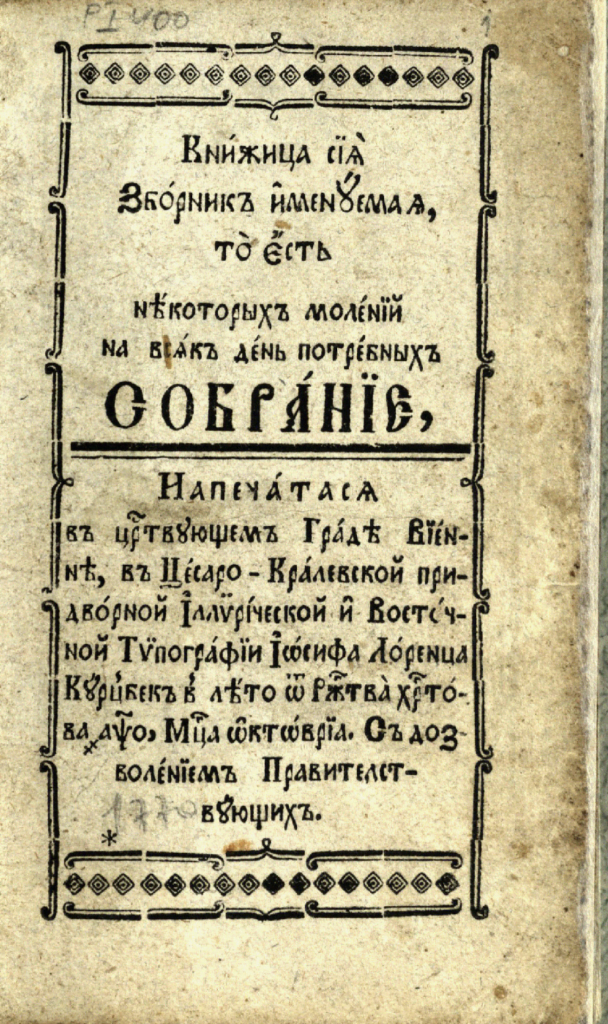 Here’s an example, a book from 1770, titled “Sobraniye,” which states that it was printed in the imperial city of Vienna at the court press of Joseph Lorenz Kurzböck, in Illyrian-Eastern script. This is a small book of various prayers for all necessary days.
Here’s an example, a book from 1770, titled “Sobraniye,” which states that it was printed in the imperial city of Vienna at the court press of Joseph Lorenz Kurzböck, in Illyrian-Eastern script. This is a small book of various prayers for all necessary days.
In response to the Jesuit books, the Orthodox Church in the Austro-Hungarian territories printed Orthodox prayer books that had not existed before. The average Orthodox believer knew the “Our Father” and attended church services, while prayers or hymns were reserved for the clergy and monks. Now, following the example of the Catholics, prayer books appeared that were intended for ordinary believers. Also, at that time, the Serbian Church created the first Orthodox catechism, modeled after Catholic books of that type.
Consequences
Although these books were printed in response to the Jesuits, it seems to me that they distanced people from the source of our faith. Our people say, “Too many cooks spoil the broth,” and so it is with teachings. It’s better to be closer to the source, and that is primarily the reading of the New Testament and the Nomocanon of Saint Sava. Trebniks and psalters had existed before, but they were intended for the clergy and monks for chanting, not for the ordinary people.
The mental or silent prayer was a way for a person, through contemplation (reflection, meditation, self-examination), to examine their actions, thoughts, and situation in relation to God. When prayers are read, there is no such contemplation, and the direct addressing of God is lost. Instead of reflection and contemplation, people were pushed into a religiosity similar to what the Catholic Church imposed on its believers.
The Catholic Church places priests as mediators between God and people. They teach, listen, and confess them. In the Middle Ages, this was a way to control the people, especially in territories where the population had been Orthodox a few centuries earlier, such as in Bosnia and Croatia. This practice created a kind of religiosity among Roman Catholics where the clergy was glorified instead of addressing God directly.
In the orthodoxy of Saint Sava, the situation was originally different. Priests were merely assistants in the church, and when a person prayed, they addressed God directly through prayer.
In the 18th century, Serbs in the old territories under Turkish rule were governed by Greek Phanariotes, and in Austro-Hungary, there was a strong influence from Jesuit educators. Both sides worked to ensure that the Orthodox Church would cease to deal with law, justice, and politics, pushing the people into religiosity without interference in imperial or sultan authority.
Serbian, or Savian, orthodoxy disappeared due to two main influences. On one side, Austro-Hungary and the Catholics spread religiosity among the people, while in parallel, the ideas of the French Revolution, where Masons and Jews gradually spread the principles of secularism, grew stronger in Europe. After the Berlin Congress, these ideas of secularism were incorporated into Serbian laws by the Obrenović dynasty, and later by the Karađorđevićs, communists, and this has continued to the present day.
The adoption of secularism in Serbia was greatly influenced by the Jews. Since Saint Sava’s Nomocanon and the New Testament condemned Jews and their faith, the Jews did everything to ensure that the church was declared a “religious institution” that would be legally prohibited from interfering in governance and politics.
Jews slowly entered Serbian governance during the time of Miloš Obrenović, but this was very limited. Their true entry into power came after the Berlin Congress, when the formulation “equal rights for citizens of all religions” quietly overturned the prohibition against Jews participating in governance, education, and trade that had been in place for the previous 1,500 years. With the Jews came the influence of the Masonic movement, and secularism became one of the foundations of modern Serbia.
Once, faith meant upbringing, education, laws, the selection of rulers, politics, and diplomacy. However, Serbian religion was gradually reformed in the image of the Catholic Church. Liturgical gatherings with political and legislative purposes disappeared! Svetosavlje, as a religion of the living God, is slowly transforming to this day into impotent religious Orthodoxy, which will become a kind of sacred monument to the former Serbian empire. Being Christian no longer means gathering together, but the practice of reading prayers, liturgies, kissing hands, and lighting candles without interfering in politics or judging anyone.
Instead of the church and people defending Christian values, upbringing, and state legislation, as Saint Sava did by translating the Orthodox legal code — the Nomocanon — both the people and the church are pushed into religiosity, much like the Catholic Church. So today, we have a hollow belief in God, without effect and without law, which aligns with the principles of a secular state where the church is forbidden to interfere in legislation and politics.
One piece of this religious-secular puzzle is prayer books, compilations of prayers to be read that have replaced silent prayer.
Finally, I’ll say that silent mental prayer and prayer by reading are like a fish in a river and a fish in a bowl, like freedom and a golden cage, like looking in a mirror or looking into a shop window.
Links:
- https://www.newadvent.org/cathen/07301a.htm
- http://sabornik.rs/index.php/autorski-pogledi/2010-grigorijepalamaicardusan
- Gregory Palamas – Triads .pdf file recommended reading
- Wikipedia Philokalia
- https://en.wikipedia.org/wiki/Hesychast_controversy
- gregory-palamas-historical-timeline
- Civil War in Byzantium
Other texts on this topic:
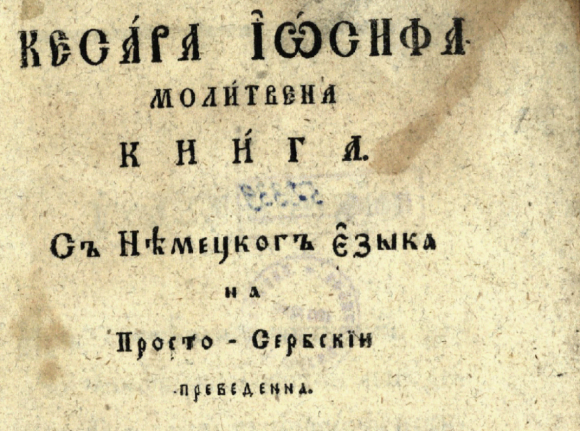
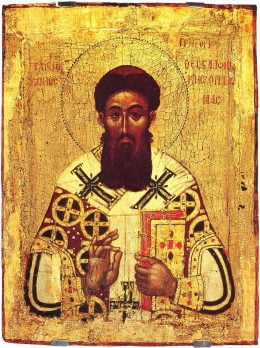
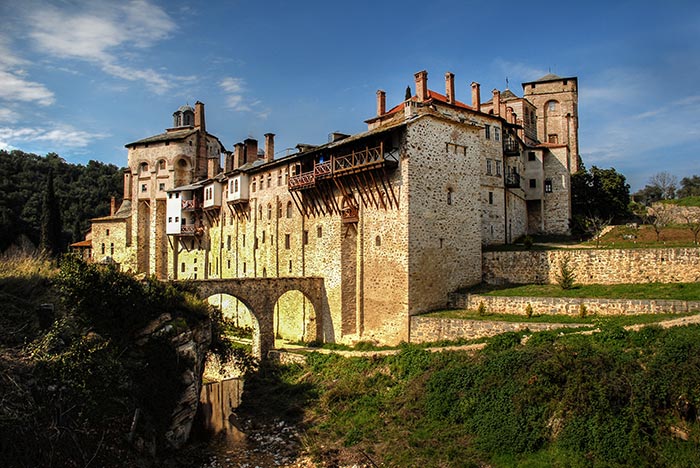










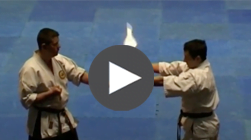
Od sveštenika koji se školovao u Solunu dolazi informacija kako je car Dušan ponudio sv. Grigoriju Palami da bude patrijarh njegovog carstva, sto Palama odbija jer se nije slagao sa jakim nacionalizmom cara Dušana. Takodje još jedna zanimljivost, kada su Turci kidnapovali Palamu, dok su ga prevozili čamcem naidjoše na srpske trgovce iz Dubrovnika, koji platiše otkupninu i oslobodiše Palamu.
Хвала Весна на коментару.
Ово за откуп је познато, међутим ухвати ме мука када слушам те наше свештенике ”образоване у Солуну” јер само шире грчку пропаганду. Понуђено је високо место у цркви, није му нудио да буде патријарх јер црква није царска прћија као данас. Цар по закону не поставља патријарха, већ обрнуто црква проглашава цара.
Прича о национализму је грчко тумачење, у оно време већину царства су чинили словени, а Душаново царство није било ”спрско” јер је он владао Србима, Грцима и Бугарима. Аргумент о национализму не стоји.